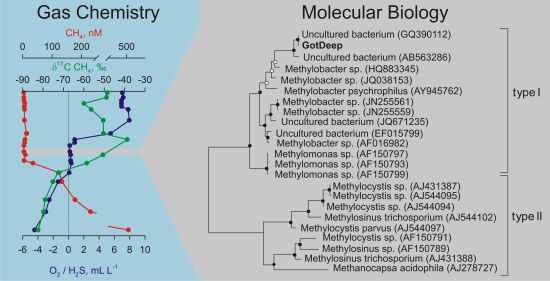
Preliminary Results
Aerobic and anaerobic turnover of methane in the water column of the central Baltic Sea (Gotland-Deep und Landsort-Deep), DFG SCHM 2530/2
Water column samples taken in summer 2008 from the stratified Gotland Deep (central Baltic Sea) showed a strong gradient in dissolved methane concentrations from high values in the saline deep water (max. 504 nM) to low concentrations in the less dense, brackish surface water (about 4 nM). The steep methane-gradient (between 115 and 135 m water depth) within the redox-zone, that separates the anoxic deep part from the oxygenated surface water (oxygen concentration 0 ‑ 0.8 ml L-1), implies a methane consumption rate of 0.28 nM d‑1. The process of microbial methane oxidation within this zone was evident by a shift of the stable carbon isotope ratio of methane between the bottom water (d13C CH4 = -82.4‰) and the redox-zone (d13C CH4 = ‑38.7‰). Water column samples between 80 and 119 m were studied to identify the microorganisms responsible for the methane turnover in that depth interval. Notably, methane monoxygenase gene expression analyses for water depths covering the whole redox-zone demonstrated that accordant methanotrophic activity was probably due to only one phylotype of the aerobic type I methanotrophic bacteria. An imprint of these organisms on the particular organic matter was revealed by distinctive lipid biomarkers showing bacteriohopanepolyols and lipid fatty acids characteristic for aerobic type I methanotrophs (e.g., 35-aminobacteriohopane-30,31,32,33,34-pentol), corroborating their role in aerobic methane oxidation in the redox-zone of the central Baltic Sea.

Within this DFG funded project we are applying a multidisciplinary approach that combines gas chemistry, molecular biology and lipid biomarker geochemistry. The biological investigations are coordinated by Priv. Doz. Dr. Matthias Labrenz (IOW), the biomarker studies by Dr. Martin Blumenberg (Geobiology Group, Geoscience Centre, Georg-August-University Göttingen, Germany) and the gas chemistry by Dr. Oliver Schmale (IOW). Gunnar Jakobs is the PhD student who is working in this project at the IOW.
References
Schmale O., Schneider von Deimling J., Gülzow W., Nausch G., Waniek J. J., and Rehder,G.: Distribution of methane in the water column of the Baltic Sea, Geophys. Res. Lett., 37, L12604, doi:10.1029/2010gl043115, 2010.
Schmale O., Blumenberg M., Kießlich K., Jakobs G., Berndmeyer C., Labrenz M., Thiel V., and Rehder G. (2012), Aerobic methanotrophy within the pelagic redox-zone of the Gotland Deep (central Baltic Sea), Biogeosciences, 9, 4969-4977, 2012.
Berndmeyer C., Thiel V., Schmale O., and Blumenberg M. (2013). Biomarkers for aerobic methanotrophy in the water column of the stratified Gotland Deep (Baltic Sea), Organic Geochemistry, 55, 103-111, 2013.
Blumenberg M., Berndmeyer C., Moros M., Muschalla M., Schmale O., and Thiel V. (2013). Bacteriohopanepolyols record stratification, nitrogen fixation and other biogeochemical perturbations in Holocene sediments of the central Baltic Sea, Biogeosciences, 10, 2725-2735, 2013.
. Comparative studies of pelagic microbial methane oxidation within two anoxic basins of the central Baltic Sea (Gotland Deep and Landsort Deep), Biogeosciences Discuss., 10, 12251-12284, 2013.
Jakobs G., Labrenz M., Rehder G., Hietanen S., Kießlich K., Vogts A., Blumenberg M., and Schmale O. (2016). A Bioreactor Approach to Investigate the Linkage between Methane Oxidation and Nitrate/Nitrite Reduction in the Pelagic Oxic-Anoxic Transition Zone of the Central Baltic Sea. Frontiers in Marine Science 3:145.
Schmale O., Krause S., Holtermann P., Power Guerra N. C., and Umlauf L. (2016). Dense bottom gravity currents and their impact on pelagic methanotrophy at oxic/anoxic transition zones. Geophys. Res. Lett., doi:10.1002/2016GL069032.